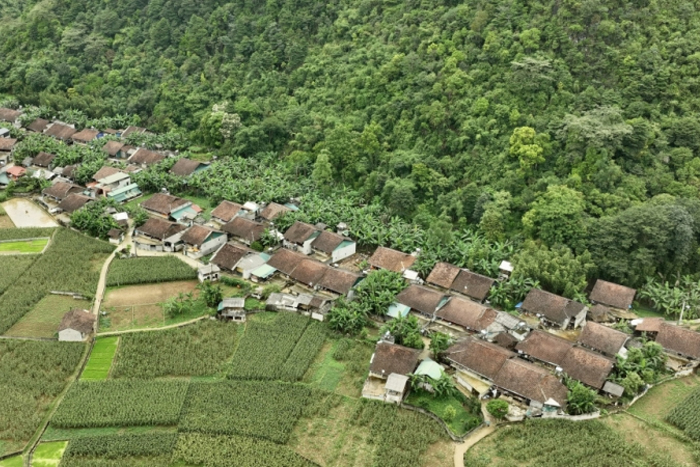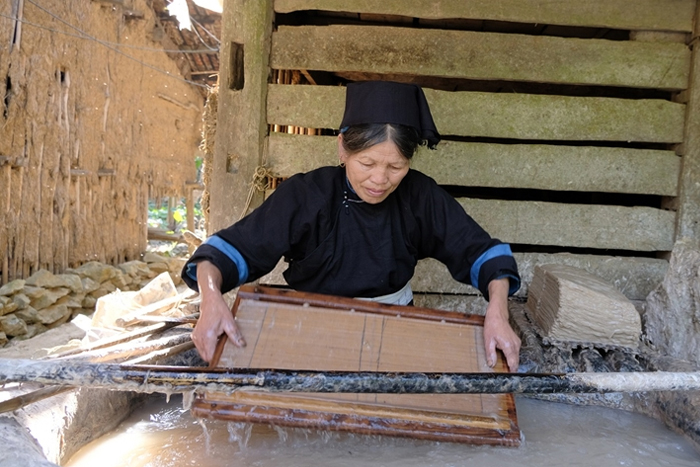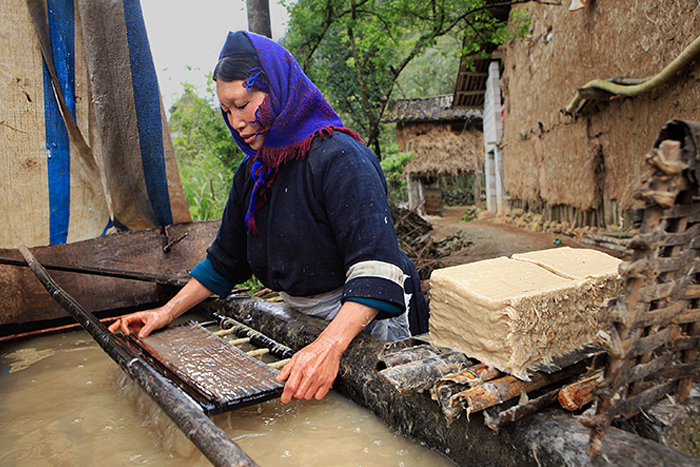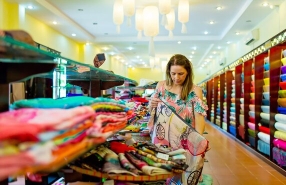
Cao Bang, just 300 km northeast of Hanoi, is an ideal destination for all visitors. Its lush forests, majestic mountains, and picturesque valleys attract travelers eager for discoveries. But that's not all: the region is also famous for its ethnic communities rich in craftsmanship. The Nùng, in particular, are renowned for their “bản” paper, skillfully made in the hamlet of Dia Tren in Cao Bang. Join us for an adventure in the paper-making village of the Nùng An in Cao Bang Vietnam, where nature and culture come together to create an unforgettable experience.
I. Why visit the paper-making village of the Nùng An?
The ancestral craftsmanship of paper artisans in the hamlet of Dìa Trên, located in Phúc Sen commune (Quảng Hòa district). Dia Tren village (Dìa Trên or Bản Dìa in Vietnamese) is home to 65 households practicing the traditional craft of paper-making, a tradition preserved for generations by the Nùng An ethnic group. This village is renowned for its unique methods of producing "giấy bản" (traditional Vietnamese paper), which has been passed down through generations. By visiting this village, you will get a glimpse of authentic Vietnam, preserving its unique traditions and local charm.
The different stages of paper-making are still carried out entirely by hand today, thus perpetuating age-old traditions. This paper production activity is deeply rooted in the traditional culture of the Nùng An people, thereby contributing to the preservation of this ancient craft while safeguarding the richness of the traditional culture of this ethnic community.

What to do in Cao Bang? Visiting the paper-making village of the Nùng An is a special experience for several reasons. You can discover how the Nùng An make paper with a famous name (“bản” paper ) using ancient methods passed down from generation to generation, observing the entire process from pulp preparation to paper drying. By visiting their village, you will also learn about their way of life and unique cultural heritage directly from the inhabitants. Many artisans offer workshops where visitors can try making their own paper, allowing them to understand and appreciate the meticulous work involved. The paper made by the Nùng An is used to create beautiful works of art and handicrafts such as lanterns, paintings, and decorations, which you can see and purchase on-site.
Moreover, the village is located in a picturesque region, offering a peaceful escape from urban life, and the natural beauty of the surroundings adds to the charm of your visit. Learning about the paper-making process and the culture of the Nùng An is both educational and enriching, giving you a deeper appreciation of the importance of preserving cultural traditions in Vietnam.
II. Unique characteristics of paper-making village of the Nùng An
The craft of making paper has been preserved and developed by the Tày and Nùng for hundreds of years. According to the village elders, the origin of this paper is unknown, but the expertise has been passed down through generations, with each new generation continuing the work of the previous one.
Making traditional paper involves many entirely manual and very complex steps. Numerous specific tools are used in the paper-making process, such as a cutting board, a wooden stick for beating, molds, stones to press the wet paper, and a large kitchen pot, among others. The main material used to produce traditional paper is the bark of the May Sla tree (in the local language). The dried bark is hung above the cooking stove to be used throughout the year.
The process of making the paper involves soaking strips of dried bark until they soften, then cooking them in lime water. The bark is then cleaned, soaked in running water, ground, and placed in a water tank with oil extracted from the Khua Hao tree. The pulp is molded to form sheets of paper, which are then brushed and dried on surfaces such as walls.
This traditional paper is white and has a characteristic smell of local plants and lime water. Common sizes are 20-25 cm and 40-80 cm. The inhabitants of Cao Bang Vietnam believe that their ancestors and the spiritual world only receive their respect through offerings made with traditional paper and Phja Thap incense. For each Tày and Nùng individual, from birth to death, rituals are an integral part of their life. Traditional “ ban” paper is always present in these rituals.
III. Some useful travel tips
If you plan to travel to Cao Bang Vietnam, be sure to include the traditional paper-making village (Dia Tren village ) in your itinerary. You will no longer have to wonder what to do in Cao Bang. Exploring this village will leave you with unforgettable memories as you discover an authentic Vietnam, steeped in traditions and local charm that you won't find anywhere else in the world.
Here are some useful tips for your visit to paper-making village of the Nùng An in Cao Bang Vietnam:
Research in advance: Learn about the village, its traditions, history, and available activities before your arrival.
Transport: Ensure you plan your transportation to the village, whether it’s public transport, car rental, or hiring a local guide.
Accommodation: Check the accommodation options available near the village and book in advance if necessary.
Dress code: Dress appropriately and respectfully according to the local culture during your visit to the village.
Respect for residents : Respect the customs and privacy of the villagers during your stay. Ask for permission before taking photos and be respectful of their way of life.
Cultural exchange: Take the opportunity to interact with the locals, ask questions about their way of life, traditions, and crafts. This will enrich your travel experience and promote positive cultural exchanges.
In conclusion, a visit to the paper-making village of the Nùng An in Cao Bang Vietnam, offers a unique opportunity to discover an authentic and preserved aspect of Vietnamese culture. By following these useful tips, you can fully enjoy your experience, learn about local traditions, support local artisans, and create unforgettable memories. May your journey be filled with enriching discoveries and memorable encounters!
We hope the information about Dia Tren village: paper-making village of the
Nùng An in Cao Bang Vietnam is helpful and assists you in having an enjoyable and authentic experience in
Cao Bang Vietnam. We believe you will have a wonderful journey and many memorable experiences. For a satisfying experience that exceeds your expectations, please CONTACT ATOUR ASIA,
Vietnam Travel Agency now.






























